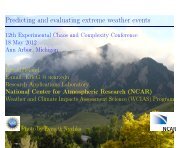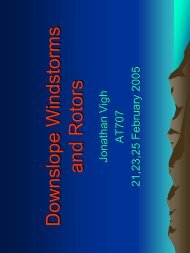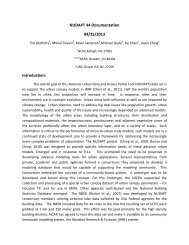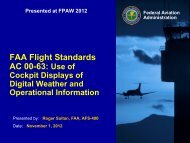Estimation of Source Parameters for Hazard Releases
Estimation of Source Parameters for Hazard Releases
Estimation of Source Parameters for Hazard Releases
Create successful ePaper yourself
Turn your PDF publications into a flip-book with our unique Google optimized e-Paper software.
<strong>Source</strong> Term <strong>Estimation</strong> <strong>for</strong><br />
<strong>Hazard</strong>ous <strong>Releases</strong><br />
Fukushima Workshop<br />
NCAR, 22 nd – 23 rd February 2012<br />
Dstl/DOC61790<br />
Dr. Gareth Brown
Presentation Outline<br />
• Dstl’s approach to <strong>Source</strong> Term <strong>Estimation</strong><br />
• Recent developments<br />
– Spatially and temporally gridded urban met object<br />
– Processing <strong>of</strong> deposition measurements<br />
• Toy example<br />
• Application to Fukushima<br />
© Crown Copyright 2012<br />
UK UNCLASSIFIED<br />
Dstl is part <strong>of</strong> the<br />
Ministry <strong>of</strong> Defence
<strong>Source</strong> Term <strong>Estimation</strong> Monte Carlo<br />
Bayesian Data Fusion (MCBDF)<br />
• MCBDF provides a<br />
set <strong>of</strong> likely source<br />
terms <strong>for</strong> calculating<br />
probabilistic hazards<br />
• Accounts <strong>for</strong><br />
uncertainty in source,<br />
meteorology, sensor<br />
per<strong>for</strong>mance &<br />
human reporting<br />
© Crown Copyright 2012<br />
UK UNCLASSIFIED<br />
P. Robins, V. Rapley, N. Green, Realtime<br />
Dstl is part <strong>of</strong> the<br />
Sequential Inference <strong>of</strong> Static Ministry <strong>Parameters</strong> <strong>of</strong> Defence with<br />
Expensive Likelihood Calculations (2009)
Bayes’ Theorem<br />
p( θ y) ∝ p( yθ) p( θ)<br />
Posterior<br />
probability density<br />
<strong>of</strong> hypothesis θ<br />
given the data y<br />
Likelihood<br />
probability density<br />
<strong>of</strong> the data y<br />
conditional on the<br />
hypotheses θ<br />
Prior<br />
probability<br />
density <strong>of</strong> θ<br />
based on prior<br />
knowledge<br />
• Iterative update <strong>of</strong> belief in a hypothesis<br />
• Likelihood calculation particularly costly<br />
– Necessary to run dispersion model <strong>for</strong> sensor data<br />
– Sensor likelihood function complex<br />
© Crown Copyright 2012<br />
UK UNCLASSIFIED<br />
Dstl is part <strong>of</strong> the<br />
Ministry <strong>of</strong> Defence
MCBDF: Bayesian data fusion<br />
• MCBDF uses Bayesian inference over a sample set <strong>of</strong><br />
hypothesized source-terms and Met. variables<br />
θ<br />
1<br />
= <br />
* x * y L 0<br />
<br />
<strong>Source</strong>−term<br />
Met<br />
( xytmdau , , , , , , , u , ,ln z , DP , )<br />
( ) <br />
Model<br />
• The dimensionality <strong>of</strong> problem depends on its complexity<br />
– Complex source terms<br />
– Gridded meteorology in time and space<br />
– Urban dispersion<br />
© Crown Copyright 2012<br />
UK UNCLASSIFIED<br />
Dstl is part <strong>of</strong> the<br />
Ministry <strong>of</strong> Defence
Physics Modelling<br />
• Dispersion is a turbulent process<br />
θ<br />
( x, t , t )<br />
1<br />
– Impossible to model accurately<br />
– Use ensemble puff dispersion models<br />
– SPRINT model optimised <strong>for</strong> STE<br />
– Implements SCIPUFF closure relations<br />
2<br />
⎛<br />
2<br />
ccc , ′ ⎞<br />
⎜ ⎟<br />
⎫ dispersion ⎜<br />
2<br />
⎟<br />
⎬ ⎯⎯⎯⎯⎯⎯⎯⎯→ p⎜ χχχ , ′ ⎟<br />
⎭ ⎜ ⎟<br />
2<br />
⎜χd χd,<br />
χ′<br />
⎟<br />
d<br />
⎝ ⎠<br />
© Crown Copyright 2012<br />
UK UNCLASSIFIED<br />
Dstl is part <strong>of</strong> the<br />
Ministry <strong>of</strong> Defence
MCBDF: Example Prior<br />
© Crown Copyright 2012<br />
UK UNCLASSIFIED<br />
Dstl is part <strong>of</strong> the<br />
Ministry <strong>of</strong> Defence
Sensor Likelihood Calculations<br />
• When CB sensor measurements are passed to MCBDF<br />
the likelihood is calculated as<br />
(<br />
2) ( ) (<br />
2<br />
µσ µσ )<br />
py| , = ∫ pyc | pc| , dc<br />
<br />
y ≡<br />
∞<br />
Sensor measurement<br />
0 measurement concentration<br />
density density<br />
µ ≡ Mean mass-concentration from dispersion simulation<br />
2<br />
σ ≡ Mass concentration variance from dispersion simulation<br />
c ≡ Unobserved ground-truth concentration<br />
© Crown Copyright 2012<br />
UK UNCLASSIFIED<br />
Dstl is part <strong>of</strong> the<br />
Ministry <strong>of</strong> Defence
MCBDF: Upon Receipt <strong>of</strong> a Detection<br />
© Crown Copyright 2012<br />
UK UNCLASSIFIED<br />
Dstl is part <strong>of</strong> the<br />
Ministry <strong>of</strong> Defence
Estimating the Posterior<br />
Distribution<br />
( θ y)<br />
( θ) ( θ)<br />
p ∝ ∏ p y p<br />
i<br />
• Calculated as the product <strong>of</strong> the individual likelihoods<br />
and the prior<br />
• Posterior estimated by sampling lots <strong>of</strong> hypotheses<br />
• MCBDF uses Differential Evolution Markov Chain<br />
(DEMC) Monte Carlo to generate new hypotheses<br />
i<br />
© Crown Copyright 2012<br />
UK UNCLASSIFIED<br />
Dstl is part <strong>of</strong> the<br />
Ministry <strong>of</strong> Defence
Calculating <strong>Hazard</strong> Areas<br />
• The <strong>Hazard</strong> Calculator<br />
obtains the probability <strong>of</strong><br />
exceeding a specified<br />
threshold dosage<br />
• A weighted sum <strong>of</strong> these<br />
gridded probabilities is<br />
used to define the<br />
probable hazard area<br />
Release location<br />
Sensor network<br />
Red: ground truth; green: predicted<br />
© Crown Copyright 2012<br />
UK UNCLASSIFIED<br />
Dstl is part <strong>of</strong> the<br />
Ministry <strong>of</strong> Defence
© Crown Copyright 2012<br />
UK UNCLASSIFIED<br />
Dstl is part <strong>of</strong> the<br />
Ministry <strong>of</strong> Defence
Recent Developments<br />
• MCBDF initially developed <strong>for</strong> rapid warning <strong>of</strong> chemical<br />
attacks based on input from sensor networks<br />
– Short effective duration approximates to spatially and temporally<br />
invariant meteorology<br />
• However STE <strong>for</strong> Bio and Rad releases in major cities<br />
requires<br />
– Fast dispersion models accounting <strong>for</strong> urban areas<br />
– Much longer temporal windows<br />
– Efficient methods to compute long duration dosage / deposition<br />
– Spatially varying meteorology <strong>for</strong> large scale dispersion<br />
© Crown Copyright 2012<br />
UK UNCLASSIFIED<br />
Dstl is part <strong>of</strong> the<br />
Ministry <strong>of</strong> Defence
Meteorological Inference<br />
• Urban capability<br />
• Gridded urban meteorological model<br />
defined<br />
– Wind flow components gridded in 2D<br />
space and time<br />
– Surface properties gridded in 2D space<br />
– Atmospheric stability gridded in time<br />
• 60 – 400 extra dimensions in<br />
parameter space<br />
– MCMC techniques still efficient if<br />
converged<br />
– Much more difficult to achieve<br />
convergence<br />
f<br />
Sykes et al, SCIPUFF Tech Doc<br />
⎡ ⎛<br />
( zh , , α ) = exp ⎢−α<br />
⎜1−<br />
⎣ ⎝<br />
c c c c<br />
Canopy height<br />
z<br />
h<br />
c<br />
⎞⎤<br />
⎟⎥<br />
⎠⎦<br />
Canopy flow parameter<br />
© Crown Copyright 2012<br />
UK UNCLASSIFIED<br />
Dstl is part <strong>of</strong> the<br />
Ministry <strong>of</strong> Defence
Toy Problem Example<br />
• Single, short duration release<br />
• Single isotope<br />
• Quantitative deposition measurements<br />
• Spatially gridded, but temporally invariant meteorology<br />
• No transport due to rain run-<strong>of</strong>f be<strong>for</strong>e measurements<br />
taken<br />
© Crown Copyright 2012<br />
UK UNCLASSIFIED<br />
Dstl is part <strong>of</strong> the<br />
Ministry <strong>of</strong> Defence
Deposition data<br />
• Likelihood model <strong>for</strong> quantitative measurement <strong>of</strong><br />
deposited material<br />
– Assume local detection only, alpha, beta, not longrange<br />
gamma<br />
– Uncertainty per measurement, not fixed<br />
• Time taken to collect Poisson count statistics<br />
• Energy spectrum uncertainty on which isotope is being measured<br />
• Naturally occurring background (with uncertainty) subtracted<br />
• Simple, normally distributed measurement error model<br />
• Lower limit and saturation can be input<br />
© Crown Copyright 2012<br />
UK UNCLASSIFIED<br />
Dstl is part <strong>of</strong> the<br />
Ministry <strong>of</strong> Defence
Sample Points<br />
• 88 points<br />
• 20km<br />
exclusion zone<br />
shown<br />
• Release point<br />
known<br />
• No met data<br />
© Crown Copyright 2012<br />
UK UNCLASSIFIED<br />
Dstl is part <strong>of</strong> the<br />
Ministry <strong>of</strong> Defence
<strong>Hazard</strong> Plot<br />
• First<br />
measurement<br />
above<br />
background<br />
• Close to<br />
source<br />
• Huge met<br />
uncertainty<br />
© Crown Copyright 2012<br />
UK UNCLASSIFIED<br />
Dstl is part <strong>of</strong> the<br />
Ministry <strong>of</strong> Defence
<strong>Hazard</strong> Plot<br />
• First 3 rings <strong>of</strong><br />
data<br />
• Less<br />
uncertainty<br />
close to<br />
source<br />
© Crown Copyright 2012<br />
UK UNCLASSIFIED<br />
Dstl is part <strong>of</strong> the<br />
Ministry <strong>of</strong> Defence
<strong>Hazard</strong> Plot<br />
• 4 rings <strong>of</strong> data<br />
© Crown Copyright 2012<br />
UK UNCLASSIFIED<br />
Dstl is part <strong>of</strong> the<br />
Ministry <strong>of</strong> Defence
<strong>Hazard</strong> Plot<br />
• 6 rings <strong>of</strong> data<br />
© Crown Copyright 2012<br />
UK UNCLASSIFIED<br />
Dstl is part <strong>of</strong> the<br />
Ministry <strong>of</strong> Defence
<strong>Hazard</strong> Plot<br />
• All data<br />
• More time <strong>for</strong><br />
convergence<br />
© Crown Copyright 2012<br />
UK UNCLASSIFIED<br />
Dstl is part <strong>of</strong> the<br />
Ministry <strong>of</strong> Defence
Problems to solve <strong>for</strong> Fukushima<br />
• <strong>Parameters</strong> to infer:<br />
– Mass released in each hour over the last year<br />
– Gridded meteorology <strong>for</strong> each hour over the last year<br />
• 10km spatial resolution<br />
• Modelling:<br />
– Gamma sensors pick up spatially averaged dose<br />
• Function <strong>of</strong> range needs integrating<br />
– 1/r 2 , attenuation through air, scatter build up factors<br />
– Longer range second order closure dispersion model needed<br />
• SCIPUFF<br />
• Other?<br />
– Further transport <strong>of</strong> deposited material due to water run-<strong>of</strong>f<br />
© Crown Copyright 2012<br />
UK UNCLASSIFIED<br />
Dstl is part <strong>of</strong> the<br />
Ministry <strong>of</strong> Defence
Backup<br />
© Crown Copyright 2012<br />
UK UNCLASSIFIED<br />
Dstl is part <strong>of</strong> the<br />
Ministry <strong>of</strong> Defence
The Concentration Sensor<br />
Likelihood Model<br />
• Critical to the per<strong>for</strong>mance <strong>of</strong> MCBDF is an accurate<br />
probabilistic description <strong>of</strong> the detector’s response<br />
2<br />
σ e<br />
L<br />
L<br />
≡<br />
≡<br />
≡<br />
(<br />
2<br />
, σ ) e<br />
⎧ Φ Lc y=<br />
L<br />
( )<br />
⎪<br />
(<br />
2<br />
p yc = ⎨ φ yc,<br />
σ ) e<br />
L< y<<br />
L<br />
⎪<br />
(<br />
2<br />
⎪1 −Φ Lc,<br />
σ ) =<br />
⎩<br />
e<br />
y L<br />
Measurement error variance<br />
Sensor saturation point<br />
Sensor limit <strong>of</strong> detection<br />
normal distribution CDF<br />
© Crown Copyright 2012<br />
UK UNCLASSIFIED<br />
Dstl is part <strong>of</strong> the<br />
Ministry <strong>of</strong> Defence
Deposition modelling<br />
• Improved physics improves consistency <strong>of</strong> sensor data<br />
likelihood modelling<br />
– More accurate source term estimation in presence <strong>of</strong> deposition<br />
• Amount <strong>of</strong> deposition inferred from data and/or uncertainty<br />
correctly passed to hazard calculations<br />
17 February 2012<br />
© Crown Copyright 2012<br />
UK UNCLASSIFIED<br />
Dstl is part <strong>of</strong> the<br />
Ministry <strong>of</strong> Defence
Deposition data<br />
• Likelihood model <strong>for</strong> detection <strong>of</strong> deposited material already in<br />
place<br />
– Biological hazards<br />
– Similar to a probit model<br />
– Extended to include:<br />
• Probability <strong>of</strong> false alarm<br />
• Probability <strong>of</strong> false negative<br />
– Integrate out unobserved true amount <strong>of</strong> deposited material<br />
17 February 2012<br />
© Crown Copyright 2012<br />
UK UNCLASSIFIED<br />
Dstl is part <strong>of</strong> the<br />
Ministry <strong>of</strong> Defence
Prelim. deposition results (simulated met. constant)<br />
Collectors + Identifiers (dosage)<br />
+ Survey ID (deposition)<br />
20km<br />
10km<br />
10km<br />
5km<br />
1 detection,<br />
8 nulls<br />
17 February 2012<br />
© Crown Copyright 2012<br />
UK UNCLASSIFIED<br />
Dstl is part <strong>of</strong> the<br />
Ministry <strong>of</strong> Defence
Burn In and Convergence<br />
• Initial hypotheses may be far from the<br />
peak <strong>of</strong> the posterior<br />
• But rapid answers are required<br />
– Data continually changing the posterior<br />
– limited time <strong>for</strong> new sample weights to<br />
make the old ones insignificant<br />
– Limited time <strong>for</strong> samples to spread out and<br />
capture true uncertainty<br />
• Detection <strong>of</strong> non-convergence delays<br />
message processing<br />
Re-weight<br />
Re-sample<br />
17 February 2012<br />
© Crown Copyright 2012<br />
UK UNCLASSIFIED<br />
Dstl is part <strong>of</strong> the<br />
Ministry <strong>of</strong> Defence
<strong>Hazard</strong> Calculation<br />
• Probit slope model<br />
– S used to indicate uncertainty in appropriate value <strong>for</strong><br />
χ d 50<br />
1 ⎛ ⎛ S 1 log<br />
2 ⎜ ⎜<br />
⎝ ⎝ 2<br />
( χd<br />
) = ⎜ + erf ⎜<br />
10<br />
p <strong>Hazard</strong><br />
⎛ χd<br />
⎜<br />
⎝χ<br />
d 50<br />
⎞⎞⎞<br />
⎟<br />
⎟<br />
⎠<br />
⎟<br />
⎠⎠<br />
∞<br />
( , ′ 2 ) ( , ′<br />
2<br />
) ( )<br />
p <strong>Hazard</strong> χ χ = ∫ p χ χ χ p <strong>Hazard</strong> χ dχ<br />
d d d d d d d<br />
0<br />
• Average over 1000 release/met samples from posterior.<br />
17 February 2012<br />
© Crown Copyright 2012<br />
UK UNCLASSIFIED<br />
Dstl is part <strong>of</strong> the<br />
Ministry <strong>of</strong> Defence
Deposition data likelihood (clipped normal)<br />
2<br />
( χd,<br />
σe<br />
)<br />
2<br />
( , )<br />
2<br />
( χd<br />
σe<br />
)<br />
⎧ Φ L y = L<br />
⎪<br />
p( y χd)<br />
= ⎨ φ y χd σe<br />
L< y<<br />
L<br />
⎪<br />
⎪1 −Φ L , y = L<br />
⎩<br />
2 2<br />
( χ , ) unclipped<br />
( ,<br />
d<br />
χ ′<br />
d<br />
⎯ ⎯ ⎯ ⎯→ µ<br />
N<br />
σN)<br />
∞<br />
⎧<br />
2 2 2<br />
⎪ ( L χd, σ ) ⎡<br />
e ( 0 µ<br />
N, σN) δ ( χd) φ( χ<br />
d<br />
µ<br />
N,<br />
σ ) ⎤<br />
∫ Φ Φ +<br />
N<br />
dχd<br />
y = L<br />
⎣ ⎦<br />
⎪ 0<br />
∞<br />
2 ⎪ 2 2 2<br />
p( y µ<br />
N, σN)<br />
= ⎨ φ( y χd, σ<br />
e ) ⎡ ( 0 µ<br />
N, σN) δ ( χd) φ( χ<br />
d<br />
µ<br />
N,<br />
σN)<br />
⎤<br />
∫<br />
Φ + dχd<br />
L< y<<br />
L<br />
⎣ ⎦<br />
⎪ 0<br />
⎪∞<br />
2 2 2<br />
⎪ ( 1 ( L χd, σ<br />
e )) ⎡ ( 0 µ<br />
N, σN) δ ( χd) φ( χ<br />
d<br />
µ<br />
N,<br />
σN)<br />
⎤<br />
∫ −Φ Φ + dχd<br />
y = L<br />
⎣<br />
⎦<br />
⎪⎩ 0<br />
L<br />
⎧<br />
2 2 2<br />
⎪ Φ( L 0, σ<br />
e ) Φ ( 0 µ<br />
N, σ<br />
N) + k( y) ⎡1 ( 0 µ ( y) , σ ( y)<br />
) ⎤<br />
∫ −Φ dy y = L<br />
⎣ ⎦<br />
⎪<br />
−∞<br />
2 ⎪ 2 2 2<br />
p( y µ<br />
N, σN)<br />
= ⎨ φ( y 0, σ<br />
e ) Φ ( 0 µ<br />
N, σ<br />
N) + k( y) ⎡1 −Φ ( 0 µ ( y) , σ ( y)<br />
) ⎤ L< y<<br />
L<br />
⎣ ⎦<br />
⎪<br />
∞<br />
⎪ ⎡<br />
2 2 2<br />
1−Φ( L 0, σ<br />
e ) ⎤ Φ ( 0 µ<br />
N, σ<br />
N) + k( y) ⎡ 1−Φ ( 0 µ ( y) , σ ( y)<br />
) ⎤ dy y = L<br />
⎪⎣ ⎦ ∫ ⎣ ⎦<br />
⎩<br />
L<br />
2 2<br />
( x , ) ≡ ( x , )<br />
φ µσ φ µ σ<br />
σ<br />
σσ<br />
2 2<br />
2 1 2<br />
=<br />
2 2<br />
σ1 + σ2<br />
2 µ<br />
1<br />
µ<br />
2<br />
µ σ ⎛ ⎞<br />
= ⎜ + σ<br />
2 2 ⎟<br />
⎝ 1 σ<br />
2 ⎠<br />
k<br />
( x , 2 ) ( x , 2 ) ≡ k ( x ,<br />
2<br />
)<br />
1 1 2 2<br />
φ µ σ φ µ σ φ µ σ<br />
σ<br />
=<br />
σσ<br />
1 2<br />
2<br />
e<br />
π<br />
2 2 2<br />
1⎛µ 1 µ 2 µ ⎞<br />
− + −<br />
2⎜<br />
2 2 2<br />
σ1 σ2<br />
σ ⎟<br />
⎝<br />
⎠<br />
Romberg (closed and semi-infinite) numerical integration<br />
17 February 2012<br />
© Crown Copyright 2012<br />
UK UNCLASSIFIED<br />
Dstl is part <strong>of</strong> the<br />
Ministry <strong>of</strong> Defence
Deposition data likelihood (clipped gamma)<br />
2<br />
( χd,<br />
σe<br />
)<br />
2<br />
( , )<br />
2<br />
( χd<br />
σe<br />
)<br />
⎧ Φ L y = L<br />
⎪<br />
p( y χd)<br />
= ⎨ φ y χd σe<br />
L< y<<br />
L<br />
⎪<br />
⎪1 −Φ L , y = L<br />
⎩<br />
2 *<br />
( χ , ) ( , ,<br />
d<br />
χ′ d<br />
⎯ ⎯→ sk λ)<br />
Romberg (closed and<br />
semi-infinite)<br />
numerical integration<br />
⎧<br />
⎡<br />
⎛ ⎛χd<br />
+ λ ⎞⎞<br />
⎤<br />
*<br />
⎪ ∞<br />
⎢<br />
k −1<br />
exp<br />
2 χd<br />
λ ⎜ − ⎜ ⎟<br />
s ⎟<br />
⎥<br />
⎪<br />
⎛ + ⎞ ⎝ ⎠<br />
Φ ( L χd, σ ) ⎢<br />
⎝ ⎠<br />
e<br />
+ (1 − γδχ ) ( ) ⎥<br />
*<br />
d<br />
dχd<br />
y = L<br />
⎪ ∫<br />
⎢<br />
⎜ ⎟<br />
s s ( k )<br />
0<br />
⎝ ⎠ Γ<br />
⎥<br />
⎪<br />
⎢<br />
⎥<br />
⎪<br />
⎣<br />
⎦<br />
⎪<br />
⎡<br />
χd<br />
λ<br />
⎤<br />
⎪<br />
⎛ ⎛ + ⎞⎞<br />
*<br />
∞<br />
⎢<br />
k −1<br />
exp<br />
2 2 χd<br />
λ ⎜ − ⎜ ⎟<br />
s ⎟<br />
⎥<br />
⎪<br />
⎛ + ⎞ ⎝ ⎠<br />
p( y µ<br />
N, σN)<br />
= φ( y χd, σ<br />
⎝ ⎠<br />
⎨<br />
e ) ⎢<br />
(1 γδχ ) ( ) ⎥<br />
∫<br />
⎜ ⎟<br />
+ −<br />
*<br />
d<br />
dχd<br />
L< y<<br />
L<br />
⎪<br />
⎢ s s ( k )<br />
0<br />
⎝ ⎠ Γ<br />
⎥<br />
⎪<br />
⎢<br />
⎥<br />
⎣<br />
⎦<br />
⎪<br />
⎪ ⎡<br />
⎛ ⎛χd<br />
+ λ ⎞⎞<br />
⎤<br />
⎪<br />
*<br />
∞<br />
⎢<br />
k −1<br />
exp<br />
2 ⎛χd<br />
+ λ ⎜ − ⎜ ⎟<br />
⎞<br />
s ⎟<br />
⎥<br />
⎪ ( 1 −Φ( L χd,<br />
σe<br />
))<br />
⎢<br />
⎝ ⎝ ⎠⎠<br />
⎜ ⎟<br />
+ (1 − γδχ ) ( ) ⎥<br />
*<br />
d<br />
dχd<br />
y = L<br />
⎪∫<br />
⎢⎝<br />
s<br />
0<br />
⎠ sΓ( k )<br />
⎥<br />
⎢<br />
⎥<br />
⎪⎩<br />
⎣ ⎦<br />
⎧<br />
⎡<br />
⎛ ⎛χd<br />
+ λ ⎞⎞⎤<br />
*<br />
⎪<br />
∞<br />
⎢<br />
k −1<br />
exp<br />
2 2 χd<br />
λ ⎜ − ⎜ ⎟<br />
s ⎟⎥<br />
⎪<br />
⎛ + ⎞ ⎝ ⎠<br />
Φ( L 0, σe )( 1− γ) + Φ( L − χd 0, σ ) ⎢<br />
⎝ ⎠⎥<br />
e<br />
dc y = L<br />
*<br />
⎪<br />
∫<br />
⎢<br />
⎜ ⎟<br />
( )<br />
0<br />
⎝ s ⎠ sΓ<br />
k ⎥<br />
⎪<br />
⎢<br />
⎥<br />
⎪<br />
⎣<br />
⎦<br />
⎪<br />
⎡<br />
χd<br />
λ ⎤<br />
⎪<br />
⎛ ⎛ + ⎞⎞<br />
*<br />
∞<br />
⎢<br />
k −1<br />
exp<br />
2 2 2 χd<br />
λ ⎜ − ⎜ ⎟<br />
s ⎟⎥<br />
⎪<br />
⎛ + ⎞ ⎝ ⎠<br />
p ( y µ<br />
N, σN)<br />
= φ( y 0, σe )( 1 γ) φ( y χd,<br />
σ<br />
⎝ ⎠<br />
⎨<br />
− +<br />
e ) ⎢<br />
⎥<br />
∫<br />
⎜ ⎟<br />
dc L < y < L<br />
*<br />
⎪<br />
⎢ s s ( k )<br />
0<br />
⎝ ⎠ Γ ⎥<br />
⎪<br />
⎢<br />
⎥<br />
⎣<br />
⎦<br />
⎪<br />
⎪ ⎡<br />
⎛ ⎛χd<br />
+ λ ⎞⎞⎤<br />
⎪ ∞<br />
⎢<br />
k<br />
2 2<br />
( 1−Φ( L 0, σe ))( 1− γ) + ( 1−Φ( L−χd 0, σe<br />
))<br />
* −1<br />
exp<br />
χd<br />
λ ⎜ − ⎜ ⎟<br />
s ⎟⎥<br />
⎪ ⎢⎛ + ⎞ ⎝ ⎝ ⎠⎠<br />
⎜ ⎟<br />
⎥dc x = L<br />
*<br />
⎪<br />
∫<br />
⎢ s sΓ( k ) ⎥<br />
0<br />
⎝ ⎠<br />
⎢<br />
⎥<br />
⎪⎩<br />
⎣ ⎦<br />
17 February 2012<br />
© Crown Copyright 2012<br />
UK UNCLASSIFIED<br />
Dstl is part <strong>of</strong> the<br />
Ministry <strong>of</strong> Defence
Urban meteorology<br />
• Displacement height<br />
• Canopy blending<br />
• Mean wind vector<br />
• Shifted wind vector<br />
z ( h, α ) = 0.7 hF( α )<br />
d c c c c c<br />
( α ) 2<br />
c<br />
⎛<br />
⎞<br />
Fc( αc) = 1−exp⎜−<br />
⎟<br />
⎜ 0.25 + 0.5α<br />
c ⎟<br />
⎝<br />
⎠<br />
u<br />
'<br />
( xyzt , , , ) = gxyz ( , , ) u( xyzt , , , )<br />
'<br />
' fsl<br />
( z , z0, L)<br />
ux(, xyzt , ,) =<br />
u*<br />
x(, xyt ,)<br />
k<br />
'<br />
' fsl<br />
( z , z0, L)<br />
uy(, xyzt , ,) =<br />
u*<br />
y(, xyt ,)<br />
k<br />
u(, xyzt , ,) = 0<br />
'<br />
z<br />
⎧( hc < zs + zd) and ( z < hc)<br />
⎨<br />
⎧h (<br />
c s d)<br />
c<br />
− zd<br />
if ⎩ or h ≥ z + z<br />
⎪<br />
⎪<br />
⎪ z − zd<br />
if ( hc < zs + zd) and ( hc ≤ z < zs + zd)<br />
( , , ) = ⎨<br />
⎪⎪<br />
zs if ( hc < zs + zd) and ( z ≥ zs + zd)<br />
⎪<br />
⎪⎩<br />
'<br />
z xyz<br />
• Surface layer pr<strong>of</strong>ile<br />
• Canopy layer pr<strong>of</strong>ile<br />
• Blending function<br />
⎛ z ⎞ z<br />
fsl<br />
( zz ,<br />
0, L) = ln ⎜ + 1 ⎟−Ψm( )<br />
⎝ z0<br />
⎠ L<br />
⎡ ⎛ z ⎞⎤<br />
fc( zh ,<br />
c, αc) = exp ⎢−αc⎜1<br />
− ⎟⎥<br />
⎣ ⎝ hc<br />
⎠⎦<br />
gxyz ( , , ) = F( α ) f( zh , , α ) + (1 −F( α ))<br />
c c c c c c c<br />
fsl<br />
(, zz0, L)<br />
f ( h , z , L)<br />
sl<br />
c<br />
0<br />
17 February 2012<br />
© Crown Copyright 2012<br />
UK UNCLASSIFIED<br />
Dstl is part <strong>of</strong> the<br />
Ministry <strong>of</strong> Defence
Wind vector spatial derivatives<br />
• Calculated by chain rule, e.g.:<br />
⎧ ∂gxyz<br />
( , , ) ∂αc<br />
∂gxyz<br />
( , , ) ∂hc<br />
⎪<br />
+<br />
⎪ ∂αc ∂xi ∂hc ∂xi<br />
if z < h<br />
∂gxyz ( , , ) ∂gxyz ( , , ) ∂gxyz ( , , ) ∂z<br />
= + +<br />
∂xi ⎪ ∂z0<br />
∂xi ∂z ∂xi<br />
⎪<br />
⎪<br />
if z ≥ h<br />
⎪⎩<br />
0<br />
hc < zs + z<br />
⎪<br />
∂z0<br />
d<br />
⎨<br />
hc ≥ zs + zd<br />
∂gxyz<br />
( , , )<br />
=<br />
∂x<br />
i<br />
⎧<br />
⎪<br />
⎪<br />
⎪∂gxyz<br />
( , , ) ∂αc<br />
∂gxyz<br />
( , , ) ∂hc<br />
+<br />
∂α<br />
∂x ∂h ∂x<br />
⎪<br />
⎪<br />
⎪<br />
⎪<br />
⎪<br />
c i c i<br />
∂gxyz ( , , ) ∂z<br />
∂gxyz ( , , ) ∂z<br />
0<br />
+ + <<br />
s<br />
+<br />
∂z0<br />
∂xi<br />
∂z ∂xi<br />
c<br />
c<br />
if z z z<br />
⎪<br />
⎨<br />
⎪<br />
⎪ ∂ gxyz ( , ,<br />
s<br />
+ zd) ∂αc ∂ gxyz ( , ,<br />
s<br />
+ zd)<br />
∂hc<br />
⎪<br />
+<br />
⎪ ∂αc ∂xi ∂hc ∂xi<br />
⎪ ∂ gxyz ( , ,<br />
s<br />
+ zd)<br />
∂z0<br />
⎪ + if z ≥ zs<br />
+ zd<br />
⎪ ∂z0<br />
∂xi<br />
⎪<br />
⎪<br />
∂ gxyz ( , ,<br />
s<br />
+ zd)<br />
⎛ ∂zd ∂αc<br />
∂zd<br />
∂h<br />
⎞<br />
c<br />
+<br />
⎜ + ⎟<br />
⎪⎩<br />
∂z<br />
⎝∂αc<br />
∂xi<br />
∂hc<br />
∂xi<br />
⎠<br />
d<br />
17 February 2012<br />
© Crown Copyright 2012<br />
UK UNCLASSIFIED<br />
Dstl is part <strong>of</strong> the<br />
Ministry <strong>of</strong> Defence
Hypotheses<br />
• Temporal gridding<br />
• Spatial gridding<br />
θ<br />
1<br />
( ) ( d) x y L ( ) ( c) ( αc) <br />
= <br />
1 2 <br />
* * <br />
0<br />
<strong>Source</strong>-term<br />
Meteorology<br />
( l , l , t, m,ln d ,ln v , a, u , u , ,ln z ,ln h ,ln , DP )<br />
Model<br />
• Location<br />
• Time<br />
• Mass<br />
• Duration<br />
• Deposition velocity<br />
• Agent<br />
• Friction velocity components<br />
• Reciprocal Monin Obukhov length<br />
• Surface roughness<br />
• Canopy Height<br />
• Canopy Flow<br />
• Dispersion model<br />
• Dispersion model output PDF<br />
• Floating point values used<br />
to index discrete values<br />
17 February 2012<br />
© Crown Copyright 2012<br />
UK UNCLASSIFIED<br />
Dstl is part <strong>of</strong> the<br />
Ministry <strong>of</strong> Defence
Accuracy Compared to ATP45<br />
• Concentration<br />
sensor network<br />
• Meteorology sensor<br />
• Shear LIDAR<br />
• SODAR<br />
• Multiple<br />
anenometers<br />
• Probability <strong>of</strong> hazard<br />
effect<br />
• Ground Truth<br />
• Inferred<br />
17 February 2012<br />
© Crown Copyright 2012<br />
UK UNCLASSIFIED<br />
Dstl is part <strong>of</strong> the<br />
Ministry <strong>of</strong> Defence
Uncertainty Compared to ATP45<br />
• Single prompt<br />
alarm<br />
• Forecast<br />
meteorology<br />
• Probability <strong>of</strong><br />
hazard effect<br />
• Ground<br />
Truth<br />
• Inferred<br />
17 February 2012<br />
© Crown Copyright 2012<br />
UK UNCLASSIFIED<br />
Dstl is part <strong>of</strong> the<br />
Ministry <strong>of</strong> Defence
Processing dynamic sensor data<br />
• MCBDF per<strong>for</strong>ms sourceterm<br />
estimation in realtime<br />
– A time window is<br />
maintained - typically 30<br />
minutes into the past <strong>for</strong><br />
chem, 2 days <strong>for</strong> bio<br />
• On receipt <strong>of</strong> new data,<br />
old hypotheses and old<br />
data will become obsolete<br />
and are removed as they<br />
exit the current time<br />
window<br />
– Total likelihood<br />
housekeeping<br />
• Remaining hypothesis<br />
weights are modified by<br />
the likelihood <strong>of</strong> new data<br />
17 February 2012<br />
© Crown Copyright 2012<br />
UK UNCLASSIFIED<br />
Dstl is part <strong>of</strong> the<br />
Ministry <strong>of</strong> Defence
Exam Question<br />
• <strong>Source</strong> term – means to an end<br />
• How much material is in the soil<br />
– Can the land be used <strong>for</strong> habitation or farming.<br />
17 February 2012<br />
© Crown Copyright 2012<br />
UK UNCLASSIFIED<br />
Dstl is part <strong>of</strong> the<br />
Ministry <strong>of</strong> Defence
Summary<br />
• Deposition survey data as a data source appears<br />
effective<br />
• Modelling/inference extensions required<br />
17 February 2012<br />
© Crown Copyright 2012<br />
UK UNCLASSIFIED<br />
Dstl is part <strong>of</strong> the<br />
Ministry <strong>of</strong> Defence
















